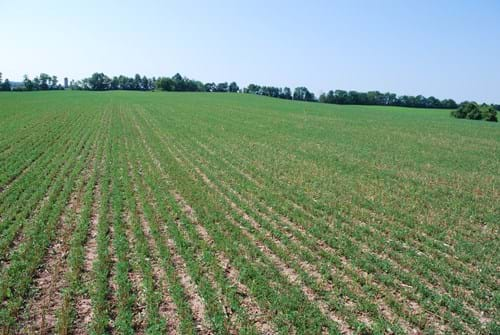Cool Start to Spring 2022; Alfalfa Planting Reminders
BY Dairyland Seed Agronomy Team
POTENTIAL PITFALLS OF PLANTING IN COLD, WET CONDITIONS
In the course of our careers, either as Farmers or Agronomists, we have all had instances where the weather forecast has switched from warm, dry and sunny to cool, cloudy and wet, while we are in the midst of planting. The problem with cold, wet weather, is that it increases the probability of Imbibitional Chilling Injury or Cold Shock Syndrome. The key words Chilling Injury or Cold Shock truly describes what takes place to the seed.

LaMoille, IL -- April 18, 2022
When a plant starts its germination process, it takes in or imbibes (absorbs) water to rehydrate the cells. That is why the seed swells. In corn, the seed must take in 30 percent of its weight in water to start the germination process. In soybeans, the seed must take in around 50 percent of its weight in water to germinate.
The first water that seeds imbibe usually occurs within the first 24 to 48 hours. If that water is cold (less than 50°F), it may cause cells to burst or “leak”. This disruption of cells in a corn seed may cause the radicle to abort. It may also cause proliferation of seminal root development, corkscrewing of the coleoptile as it leaves the seed, as well as leafing out underground. In soybeans it may cause the seed itself to swell but the radicle will not fully develop, or the initial shock may cause the seed not to germinate. Seed coat thickness and or intactness can have an impact on how quickly water enters the seed and therefore the speed of absorption.
A seed or seedling that has cold shock syndrome, takes more time to germinate, and has a higher potential for disease to infect the seed or young seedling. Quality seed treatments can help protect the plant from disease, but they cannot protect the plant from cold water. Combine Cold Shock and disease, with other factors such as soil crusting, compacted soils or deep seed placement, and you increase the likelihood of seed or seedling loss exponentially.
Another factor that may increase the severity of Cold Shock Syndrome is the actual size/shape and/or weight of the seed. It stands to reason that if you have a seed that weighs more, you will need to bring in more water to reach your 30 or 50 percent of weight. If that water is cold, you also increase the potential for injury. Large rounds in corn tend to have more of an issue or concern when dealing with Cold Shock, either due to their weight, location on the cob during harvest, thickness of the pericarp, and/or how that seed dries.
Instances of cold injury in dry soils is also very common. What happens is the cold temperatures (28°F or less) penetrate the top 1 to 3 inches of soil and kills plant tissue, the radicle and growing point.
The take home statement is that the first 24 to 48 hours in a seed’s life in the soil, is critical to the health of the plant, how many plants you potentially could have at harvest and, subsequently, yield.
KEY REMINDERS FOR PLANTING ALFALFA
Plant Quality Seed: Plant the best alfalfa you can afford with great yields and disease package. Hint, contact your local Dairyland Seed dealer, District Sales Manager or Agronomist to help with this.
Soil pH: Alfalfa is described as the “Queen of Forages/Legumes”. Remember, most legumes prefer a soil pH of 6.8 to 7.0 and, in most instances, if you need to add lime or other soil amendments to correct this, it works best to do so a year in advance.
Soil Fertility: Alfalfa produces best with higher fertility levels.
- Phosphorous (P) soil test levels should be 15 ppm or higher, 20 or more helps in higher yielding environments
- Potassium (K) soil tests levels should be 200 ppm or more, 170 is a minimum
- Sulfur (S) and Boron (B): Due to their mobile nature, these products will more than likely need to be applied every year and should be correlated with a tissue sample/soil test and yield goals for proper rates
- Nitrogen (N): Lighter soils may need 10-20 units of Nitrogen in the seedling year, prior to the alfalfa plants nodulation kicking in to supply the plants needs

Seeding Depth: Alfalfa seeds need to be planted 1/4 to ½ inch deep with the sweet spot of 3/8 of an inch. Alfalfa has to have good to excellent seed-to-soil contact for stand establishment. Rule of thumb is that your footprint should not be more than 1/4 of an inch deep when stepping in worked soil. A Brillion packer does a great job of firming up the soil and, in many instances, this is done prior to and after seeding.
Soil Temperature: Alfalfa can start to germinate with soil temperatures of 40°F or more.
Seeding Rate: 15-22 lbs. for a direct seeding and 12-18 lbs. with a companion crop.
Check Herbicide History for Carryover: Prior to seeding, check your herbicide use history on the intended field to be planted for the last two growing seasons. Certain herbicide residue can reduce plants stands or kill alfalfa seedlings.
Weed Control: A thick healthy stand and canopy help control weeds. This coupled with either pre and/or post-emerge herbicides can help produce a cleaner weed-free stand that produces a higher Relative Feed Value (RFV). Remember, weeds are taking water and nutrients away from alfalfa plants and decreasing the stand longevity. Controlling weeds early helps create a better Return on Investment (ROI).
Delay First Cutting: By delaying the first cutting until the alfalfa plant has been able to hit full flower or shortly thereafter, you are allowing the alfalfa plant the opportunity to establish its tap root system and also start storing carbohydrates within the plant. By waiting to cut, you improve the potential for increased stand longevity.
Insects and Disease:
- Insects like Potato Leafhopper and Alfalfa Weevil can have a horrific impact on alfalfa seedlings. Monitoring these insect levels and utilizing proper Integrated Pest Management (IPM) to control these pests will increase seedling health, crop quality as well as having an impact on stand longevity.
- Diseases such as Common Leaf Spot, Spring Black Stem and Leaf Spot as well as a host of others diseases can have detrimental effects on an alfalfa stand, especially seedlings. Due to the fact that your cutting time is extended on a new seeding, these diseases have a longer timeframe to affect plants and an application of a quality fungicide is strongly suggested to help control the disease(s) and offer better plant health to the alfalfa plant. In other field crops, root systems have shown a slight increase in size. If this follows suit into alfalfa, it may also help with creating a more vibrant and healthier tap root.
 |
 |
 |
 |
 |
| Brian Weller Western Region 507.456.3034 |
Dan Ritter Central Region 219.863.0583 |
Branden Furseth Northern Region 608.513.4265 |
Mark Gibson Eastern Region 260.330.8968 |
Amanda Goffnett Eastern Region 989.400.3793 |
